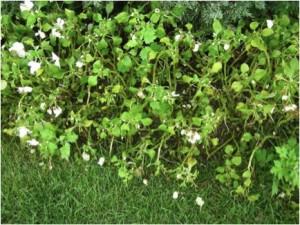Uh-Oh: Plant Diseases and Insect Pests on the Horizon
I hate to be a bearer of ill tidings, but I learned recently that one of America’s favorite bedding plants is in trouble. Impatiens is one of those plants that everyone loves: it blooms constantly all summer, it does fine in shady places, and it sheds its flowers after blooming so that you don’t need to take off the spent blossoms. The flowers themselves come in a variety of wonderful colors. There are single and double flower. All in all, a great flower. But some growers and garden centers will not be offering it for sale next summer, or will have reduced offerings.
The problem is a fungal disease called impatiens downy mildew. The disease is not new, but its prevalence is. Here in New England the disease has come up from warmer places as spores riding on the wind, much as late blight has come to our tomatoes. The bad news is this: if you had the disease this year you might not have recognized it – I didn’t at first – and once it hits your gardens, it will come back again and again. It seems to survive easily in Zone 5 (minus 20) and may even survive in Zone 4 where temperatures can reach minus 30 F.
For the past few years I have been installing impatiens in a garden on the Mall in Lebanon, NH. The garden is a mixture of sun and shade. The impatiens has done well there – until this year. The season started out well: we planted waves of small plants in berms (mounds of soil) in June. They grew and bloomed. Then the leaves started thinning out, and the plants looked a bit spindly by the end of July. There is serious root competition in these beds, so I attributed the less than stellar growth to the trees sucking up the water and nutrients.
By the end of the summer the plants were, essentially, bare stems. All the leaves and flowers had fallen off. At first I thought it might be insect damage, or perhaps slugs. But I shrugged and figured that whatever the problem was, fall was just around the corner – and next year we’d do better. I should have sent a sample to the plant diagnostic lab at UNH. Then, recently, I got an email from an alert reader, a grower who had encountered impatiens downy mildew and decided not to grow them again.
I called Dr. Cheryl Smith, UNH Extension Plant Health Specialist (unhpdl.org), who confirmed my suspicions: what I had seen in Lebanon was most likely impatiens downy mildew. I went on the Web and saw pictures and good descriptions of the disease.
Dr. Smith explained that if plants at a location had downy mildew once, it would most likely recur. She suggested carefully cleaning up flower beds that had been infected. Dig the roots out, collect all stems and leaves and bag them. That would minimize the spread of spores. Do not place the plants (or the remains of infected plants) in the compost pile, but put in household trash or burn them. Alternatively, Dr. Smith said you could bury the plants away from the garden in a site that will not be rototilled next spring.
I need to find another plant for those shady beds. New Guinea impatiens is a possible substitute, though more expensive to buy. It is not often sold in 6-packs for covering lots of territory. Coleus and begonias will often grow under the same conditions as impatiens, and are not affected by the disease. But again, they are more expensive.
Also on the horizon is an insect pest that can devastate small berries. When I called Anne Hazelrigg at UVM Cooperative Extension to learn if the problem with impatiens occurred in Vermont last summer (it did), she told me about an insect called the spotted winged drosophila. This is a fruit fly that is a new species, one that has a saw-toothed ovipositor (egg-laying device) that can wipe out fall raspberries, blueberries and even some decorative berries such as those on yews or serviceberries.
Unlike other fruit flies that only eat damaged fruit, this fly can slice open fruit to lay eggs, and the larvae then cause fruit to collapse and the white larvae to make the fruit inedible. Each fly is only about one tenth of an inch long, has red eyes, and the males have a dark spot on each wing. It became a problem first on the West Coast, got to the East Coast in Florida in 2010, and probably rode Hurricane Irene to New England. It is not easily controlled, even for those who use chemicals, and it can reproduce every eight days. There is good information on this pest on the UNH Cooperative Extension website.
Gardening sure does have its challenges. What we really need, I think, is a very cold winter. I once saw a bumper sticker that read, “30 Below Keeps Out the Riff-Raff”. We need 30 below to help control pests and diseases, so let’s hope for a good, cold winter.
Henry’s new book is out! Wobar and the Quest for the Magic Calumet is a children’s fantasy-adventure about a boy and a cougar. See www.henryhomeyer.com for more information.



